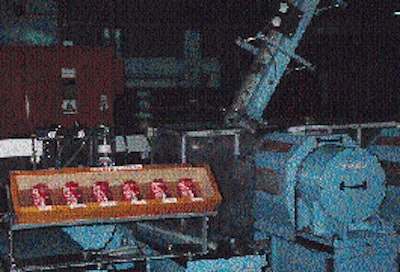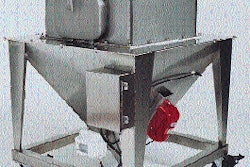In the fast-growing South African soft drink and beer markets, most beverage can makers are running at full capacity, turning out the two-piece steel cans favored in South Africa. Steel beverage cans dominate the market in South Africa, as they do in many regions of the world apart from the United States. BevCan, a leading South African can supplier, began making two-piece steel beverage cans 20 years ago, and in that time the company has seen many changes in can-making technology. BevCan has kept pace by regularly investing in new equipment, with an emphasis on more highly automated systems that can produce light-weight steel cans faster without sacrificing quality. "As can-makers go to more light-weight cans, we must put more effort into finding gentle can-handling systems," says Derek Brown, divisional technical manager at BevCan. "Particularly on high-speed lines, it is very important to get cans through efficiently but without damage." Brown and his 24-person staff provide project engineering and operational support for all BevCan plants, including facilities in Capetown, Durban, Rosslyn and Springs, site of the company's newest can making operation. As the newest of BevCan's plants, the Springs facility is also the most technologically advanced, equipped with state-of-the-art systems throughout. The plant, which opened in 1993, operates one 1귔 cans-per-minute line for two-piece steel beverage cans, along with four end lines. The best equipment "When we laid out the Springs plant, we set out to have the best equipment available," says Roy MacGregor, operations director at BevCan. "We try to keep abreast of technology. When we find something that works really well, we want it in our plants." Examples of that philosophy are everywhere. To apply various protective coatings to cans, the plant uses high-speed spray machines from Belvac (Lynchburg, VA) that operate at speeds to 900 cans/min. BevCan was the first to install these Belvac systems. According to MacGregor, instead of 14 conventional spray machines needed on a typical can line, the Springs facility uses only three on its line. Instead of standard peg ovens to cure cans after coating or decorating, BevCan uses a mat-type oven loader supplied by CSW (Deventer, The Netherlands). The mat loader keeps the coated cans separated during their trip through the oven. But because it doesn't rely on pins to hold the cans, as a peg oven does, the mat system reduces the possibility of contamination inside the can. Another characteristic of BevCan's line is their need to protect the whole base of the can because of the mat oven loader. They installed a separate bank of spray machines to put a base spray on the can base. From there, the cans go into induction ovens for curing that base coat. "We maintain a very high quality standard here at Springs, as we do at our other plants," says Eric Redelinghuys, general manager at Springs. "Our customers are very sophisticated. Our printing and coating quality is of a high standard and we run to very tight specification for pickup of iron in beer cans." This specification governing iron pickup of not more than .15 ppm after three months, is mandated by South African Breweries, a major customer. High-speed palletizing Perhaps the best example of BevCan's commitment to the latest in can-making technology at its Springs plant is the facility's palletizing operation. The company settled on a Model C1410ACS can palletizer from Goldco-Wiebe (Loveland, CO), a high-speed automated system designed to "stack and pack" empty cans efficiently and gently. The goal is to keep the can line running at optimum speed without backups and without damaging cans. An empty pallet is automatically dispensed from a pallet magazine and raised to the top of the palletizer. Cans move from the line onto the palletizer accumulator. With a sweep of the unit's patented layer separation assembly, a layer of cans is automatically palletized in the correct pattern. Once a layer of cans is in place, a patented system known as the Autoserter automatically places a slip sheet on the palletized layer, preparing the pallet for another layer. The Autoserter uses two bins filled with slip sheets. When one bin is empty, the other bin is quickly conveyed into "working" position, so the palletizing operation is never interrupted by running out of slip sheets. When the pallet is full, a special frame handler automatically places a metal frame atop the palletized load. The loaded pallet is then moved out of the palletizer hoist to the end of the discharge conveyor for handling. Goldco's Model C1410ACS can palletize loads up to 21 layers high. Fast pallet changes A palletizing system is only as efficient as its slowest point, which is usually during a pallet change. To speed up pallet changes, BevCan's system employs a continuous-motion hoist with two pairs of lifting bars. The bars are attached horizontally to drive chains at the corners of the palletizer hoist. When one set of bars is at the bottom of the hoist, the other pair is at the top, which reduces the time spent waiting for the hoist to be in position for another pallet. Another important feature of the palletizer is its ability to change can patterns quickly and precisely. Using a single switch, an operator at the main control panel can, for example, change from a #1 stagger pattern to a #2 stagger pattern. The palletizer's grabber assembly lifts the first row of cans up, shifts their position slightly, then deposits them at the back of the layer, thus altering the pattern of the entire layer. Other palletizers usually accomplish pattern changes by putting the first row of cans on a return belt to the back of the layer, a much slower process. The Goldco palletizer also incorporates several safety features. One of the most important is a safety mat located outside the hoist, between the drive chains of the discharge conveyor. An operator need only step on the mat to instantly stop the machine. Quality assurance is a key issue at Springs and at the other BevCan plants. An empty-can sorting and inspection system known as a Supersorter, also from Goldco, helps the can maker maintain its high quality standards. The semi-automated inspection system depalletizes and sorts pallet loads of empty cans suspected of containing some defects. Pallets are moved onto the unit's hoist and depalletized one layer at a time. As a layer is depalletized, cans move into an accumulator area, where powered belts running at different speeds break the can pattern and separate cans. Back to the palletizer If a layer of cans is known to be free of defects, the operator uses a moveable gate to divert these cans to a fast lane for repalletizing. Suspect cans are diverted to sorting lanes, where powered belts rotate the cans so that they can be inspected, inside and out. Rejects can be quickly diverted to a scrap bin, while good cans move back to the main conveying system for repalletizing. "The sorting system is kind of a luxury piece of equipment," MacGregor says. "But at the same time it's been an excellent investment for us." Repalletizing is handled by an R1400 semi-automatic palletizer from Goldco, located at the end of the Supersorter. The R1400, though smaller and less automated than the Model C1410ACS, uses a similar patented layer separation assembly and the same four-sided independent squaring system as used on the big, high-speed palletizer. MacGregor explains that all of BevCan's plant equipment must be extremely durable to put up with the sometimes rough handling by newer operators. New, experienced or somewhere in between, the operators at the Springs plant can at least be assured that they're using the latest can-making equipment available today.


























